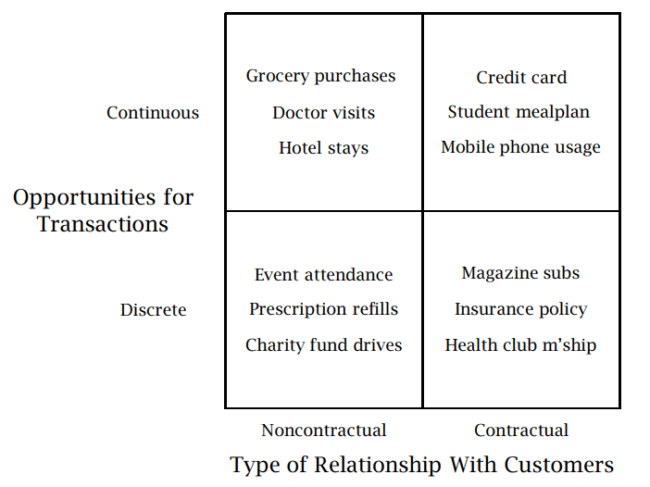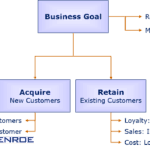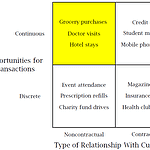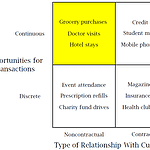Customer experience programs seek to match the organisation’s delivery with customer needs and value. At some point every CX program will need to wrestle with the question of whether a particular innovation, product feature or process change is economically justified.
At that point the only way to make a decision is to to calculate the customer lifetime value and trade it off against the investment cost.
So, in this post we examine what Customer Lifetime Value (CLV) is and how to calculate it.
Definition of Customer Lifetime Value
Customer Lifetime Value is the Net Present Value of past AND projected future purchases a customer has made/will make with an organisation, less the cost to deliver those purchases and the cost of acquiring that customer.
Net Present Value is a finance term that means the sum of value, decreased by the time value of money. This takes account of the fact that $1 of gross margin received in, say, 10 years is less valuable than $1 of gross margin received today.
Put more simply, Customer Lifetime Value is the profit that a customer generates over their relationship with a company.
Why Customer Lifetime Value is Important
Customer Lifetime Value is important because it is a more accurate method of understanding a customer’s true value to the organisation than profit from the current purchase.
Understanding CLV helps the organisation to better assign resources to maximise profits.
If you only consider a customer’s current profit you might make the wrong decision when investing in the customer and the business.
Consider a business person who travels extensively with their job but is booking a discount air ticket for their annual vacation.
An airline that didn’t recognise the person is a senior business executive who travels extensively, i.e. their broader CLV, and provide them with premium lounge access might lose much more value when the person changes preferred airlines.
Lounge access is uneconomic for the discount vacation ticket but when viewed in light of the person’s CLV it makes sound business sense.
Customer Lifetime Value Formula
Converting the above definition to a formula for CLV we get the following:

Where:
t = the year (1,2,3,4, etc) in which the Gross Margin is received and Servicing Cost is paid.
i = the annualised Weighted Average Cost of Capital – this is a finance term that has a similar meaning to the interest rate on a loan. Ask your finance team what this number is for your company.
Problems with Calculating Customer Lifetime Value
While CLV is a simple idea, it can be difficult to calculate in practice for two reasons:
Cost Uncertainty
It can be difficult to assign an exact cost for delivery and acquisition to every customer and purchase.
Future Purchase Uncertainty
Future Purchase Uncertainty is the biggest problem we encounter when calculating Customer Lifetime Value.
We know what a customer has purchased from us in the past but we can’t be sure what they might purchase in the future.
The uncertainty comes in two parts:
Changing Needs
The business person referenced above might change roles at their company, and as a result their business travel drops to zero.
Changing Suppliers
That same business person’s company might make a deal with another airline and move all travel to the new supplier.
Solutions to Future Purchase Uncertainty in the CLV Calculation
Statistics can help resolve the future purchase uncertainty problem by looking at groups of customers and calculating CLV for groups of customers rather than individual customers.
Instead of considering an individual customer we consider the average retention rate, sales, etc for a group of customers.
While we can’t sure of what any specific customer will do, we can make decisions in the business based on the average of the group of customers.
How to Calculate and Model Customer Lifetime Value
Depending on the type of relationship you have with your customers you need to approach the calculation of lifetime value in different ways.
This two-by-two chart groups the different customer relationship types that you need to consider before settling on a calculation approach.

CLV in Contractual Relationships
Calculating CLV in contractual relationships is relatively simple as you have a better understanding of the potential for future purchases.
In this case a relatively straight forward Excel or Google Sheets based customer lifetime calculator can be used.
CLV Non-Contractual Relationships – Discrete Transactions
This approach is applicable in situations where an ongoing contract does not exist but where purchases are limited to once per period.
For example: regular event attendance, non-subscription periodical magazine purchases, charity donations, mail order companies that send out a catalogue/email on a regular basis, etc.
Estimating CLV in these situations is more complex but this post provides a robust methodology: Calculating Customer Lifetime for Non-Contract Discrete transactions
CLV Non-Contractual Relationships – Continuous Transactions
This approach is applicable to CLV analysis in situations where an ongoing contract does not exist but where purchases can be made at any time.
For example retail situations; books, groceries, gifts for new employees, friends, family , etc. It is also applicable to recreational purchases, for instance hotels, restaurants, cinemas , etc. and service visits, doctors, etc.
Again, estimating CLV in these situations is more complex but this post provides a robust methodology: Calculating Customer Life Time Value in Retail Settings
How to Increase Customer Lifetime Value
From the CLV formula you can identify what drives it up and down – and so where you should focus to maximise long term value.
Here are the factors that affect Customer Lifetime Value:
| Retention Rate / Attrition Rate | The longer a customer stays, a customer, the higher the ‘t’ in the CLV calculation, i.e. the longer they stay the more they spend. Retention Rate is the inverse of ‘t’, i.e. the higher the ‘t’ the higher the retention rate. So if your service makes it more likely the customer will return in the future and spend again, you have increased the customer’s lifetime value. If bad service decreases the likelihood they will come back, you have just destroyed future cash flow, or decreased that customer’s lifetime value to you. |
| Gross Margin | Higher Gross Margins correlate with higher CLVs, i.e .the more a customer spends in each transaction the more value they generate. |
| Servicing Costs | If you can drive down average servicing costs by automation, process improvement, etc. It will increase Customer Lifetime Value |
| Customer Acquisition Costs | Reducing acquisition cost, often called sales costs, will drive up CLV |
Customer Lifetime Value FAQs
Customer Lifetime Value is an estimate of the total profit a business can expect to make from a customer over the course of their relationship. On the flip side, Customer Acquisition Cost is the cost a business incurs in order to attract a new customer, including all marketing and sales expenses. Put simply; CLV tells you how valuable a customer is, while CAC tells you how much it costs to bring in a new customer.
By determining each customer’s lifetime value, you can get a better sense of who your most valuable customers are and make sure you’re putting the right resources towards retaining them. That way, you can make sure your retention campaigns and offers are hitting the mark and delivering a positive net return. And by using CLV as a metric, you can continually tweak and improve retention strategies over time.
Knowing your customer’s lifetime value gives you valuable insights into which customers are the most valuable to your business. By focusing effort on customers with the highest lifetime value, you can make sure you’re making the right decisions for your business. Whether it be marketing strategies, product development, or customer service, having a clear understanding of your customer’s lifetime value can help guide you towards making the best investment decisions.
Knowing your customer’s lifetime value, allows to tailor your marketing campaigns and marketing spend based on likely profit. So you can allocate more resources to acquiring new customers who have the potential to be high lifetime value customers and fewer resource to customers who are likely to be lower value. In this way, you can make sure your marketing campaigns are driving the best profit across your customer base.








